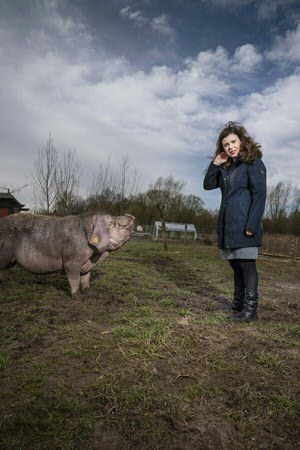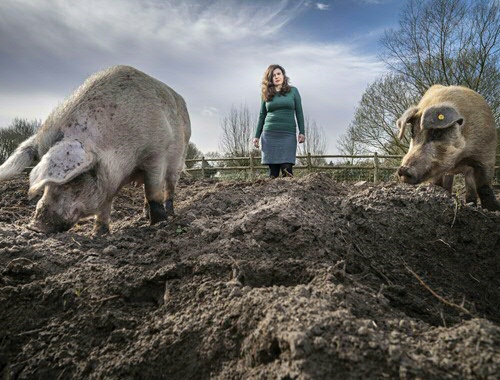Archaeology without digging

Stone Age people who no longer hunted wild animals but began ‘keeping them at home’ – archaeozoologist Canan Çakırlar investigates how animal husbandry began. This is one of the many themes explored by the Groningen Institute of Archaeology over the past hundred years.
The beginnings of agriculture: humans left behind the idyllic life of hunter-gathering and began to toil as farmers. The Biblical story of the Fall and Adam and Eve’s expulsion from Paradise is seen as a metaphor for the Neolithic revolution. But Canan Çakırlar, an archaeozoologist researching the common development of humans and livestock, sees it the other way around. ‘When people lived as hunter-gatherers, the human population was always very small: there was simply not that much to eat. In the Neolithic period, people began to domesticate animals and grow crops. The need to preserve agricultural products also prompted significant technological developments. There was more food, people consumed more protein and the population increased.’ So was the Neolithic period a sort of paradise? ‘Yes, you could say that.’
Domesticated pigs
Whatever the case, the beginnings of animal husbandry marked an important revolution in human history, including in Europe. In the Netherlands, livestock farming began sometime in the fifth millennium BC. The inhabitants of the wet dune landscape along the west coast began to keep small numbers of animals – pigs and cattle. Sheep and goats, the first animals to be domesticated in warmer regions, were not kept in the Netherlands during that time as they weren’t able to tolerate the wet landscape and cold winters. This made them unattractive as domesticated animals.
Cross-breeding
It was once believed that Dutch farmers imported all their domesticated animals from areas where livestock farming had begun at an earlier date. This is no longer so certain. There are indications that domestic pigs and wild boars frequently interbred, so much so perhaps that we are unable to distinguish between wild and domesticated pigs. There is also a lot that we don’t yet know about how animals were kept. Did pigs seek out their own food or were they fed? Were cows kept for their meat or were they milked?
Earlier excavations
With funding from the Dutch Research Council (NWO), the Groningen Institute of Archaeology has launched a major research project on how prehistoric people managed their livestock. Two PhD students and a postdoc researcher will devote themselves to the project in the coming years. Çakırlar will be supervising two of them, but there’ll be no new excavations. Çakırlar: ‘We will be digging, but only in depots – provincial depots, museum depots. We’ll use material from earlier excavations, such as the ones in Swifterbant. We are storing the material from one of the sites here, the rest we have borrowed – bone material and teeth. We’re re-examining it, using several new research methods.’

Bones and teeth
The Groningen archaeologists are employing the very latest research methods. When analysing and classifying archaeological bone and DNA material, for example, they utilize the vast knowledge now available to us about modern and historical farm animals and from the Wageningen University & Research gene bank. Even after thousands of years, it is possible to trace what an animal ate and where it lived – near the sea or in the mountains. This is done by subjecting the remains to an isotope analysis of the nitrogen, carbon, oxygen and strontium atoms that once entered the animal’s body through eating food, drinking water or breathing, becoming embedded in the animal’s bones and teeth. Radiocarbon dating has also become more precise. ‘The assumption is that the transition from hunting and gathering to agriculture took place in the Netherlands over a period of about a thousand years. But it may also have happened very quickly. We therefore need better radiocarbon dates for bone material from before, during and after the transition.’
Supplementing the animal feed
But can this really teach us how prehistoric people managed their livestock? ‘That depends on what you mean by “managed”,’ says Çakırlar. ‘We don’t know whether they petted their animals, but we are able to observe the development of relationships between humans and animals. We know about the natural vegetation in the dune landscape where these animals lived. If they roamed around freely, this would be reflected in the isotopes. If people started feeding them, for example with barley, we would be able to see that too and we can visualize if animals were fed inside a fenced enclosure.’
Milking
This might then have given rise to an even more intimate relationship: milking. Wild cows known as aurochs and even wild sheep won’t let themselves be milked. That’s simply impossible. Isotope research can trace when people began to milk animals. Once a young animal is no longer being suckled, the nitrogen content in its body drops. If people start drinking the milk instead, their nitrogen content increases. This gives people more control over young animals and over their own diet. The relationship between people and animals changes. ‘But in order to milk an animal, it has to be domesticated. That’s a genetic change. Were the animals tamed because they were milked? Or did people select the tame animals? We don’t know yet. Archaeological DNA is fragmented but, in the individual pieces, you might find the genes that make animals suitable for domestication.’
Factory farms
Livestock farming has continued to develop and industrial livestock production that we now have in Europe presents certain problems: the much-criticized factory farming and CO2 emissions. Can archaeology, through a better understanding of the beginnings of animal husbandry, contribute to a solution? ‘No, we can't offer a ready-made answer. The human population is also completely different from what it was like back then. But two things are important: the current situation is the result of human activity, which means it can be undone, if that’s what people want.’
Teaching material
‘That’s what we can learn from the past. In addition, with projects like this, we can give agricultural animals an identity. It is easy to learn how animals were managed at other times and in other places. Our research helps to paint a vivid picture. We are working with the Pre-University Academy to develop teaching material, for pre-university education (VWO) and for educational institute Terra MBO, which offers training programmes for young farmers. Because by thinking of pigs as pink, rotund animals in a pen, you are forgetting the historical evolution that they have gone through.’
Canan Çakırlar
Canan Çakırlar (Istanbul, Turkey, 1978) is an assistant professor of Archaeology and head of the zooarchaeological laboratory and bone collection at the Groningen Institute of Archaeology. Her interest in the common development of humans and animals was sparked while studying in Beirut, when she saw sea turtles nesting on the beach during an excavation of Phoenician ports. She obtained her PhD in Tübingen for research into the exploitation of cockles in ancient Troy. Since 2009, her research interests have included looking at how people and their livestock have adapted to changes in their living environment.
Groningen Institute of Archaeology celebrates its centenary
The Groningen Institute of Archaeology (GIA), which is celebrating its centenary, acquired its current form in the 1990s, when archaeologists from the Classical Institute and the Arctic Centre joined forces with the Biologisch-Archaeologisch Instituut (Biological-Archaeological Institute, BAI). Because the BAI organized its first international conference in 1920, the centenary is being celebrated this year, although its founder Professor Van Giffen had been appointed some time earlier and the building on the Poststraat was already in use. The centenary exhibition Digitall is being held at the University Museum, where you can experience the future of archaeology until 3 January 2021. The full centenary programme can be found at www.rug.nl/gia2020.
This article has been taken from our alumni magazine Broerstraat 5. Text: Joke Geelhoed-Oosterhuis / Photos: Reyer Boxem
More news
-
16 October 2025
Exploratory scenarios for the future of the Harmonie Complex
-
30 September 2025
People will always be needed
-
18 September 2025
Returning history to the community
